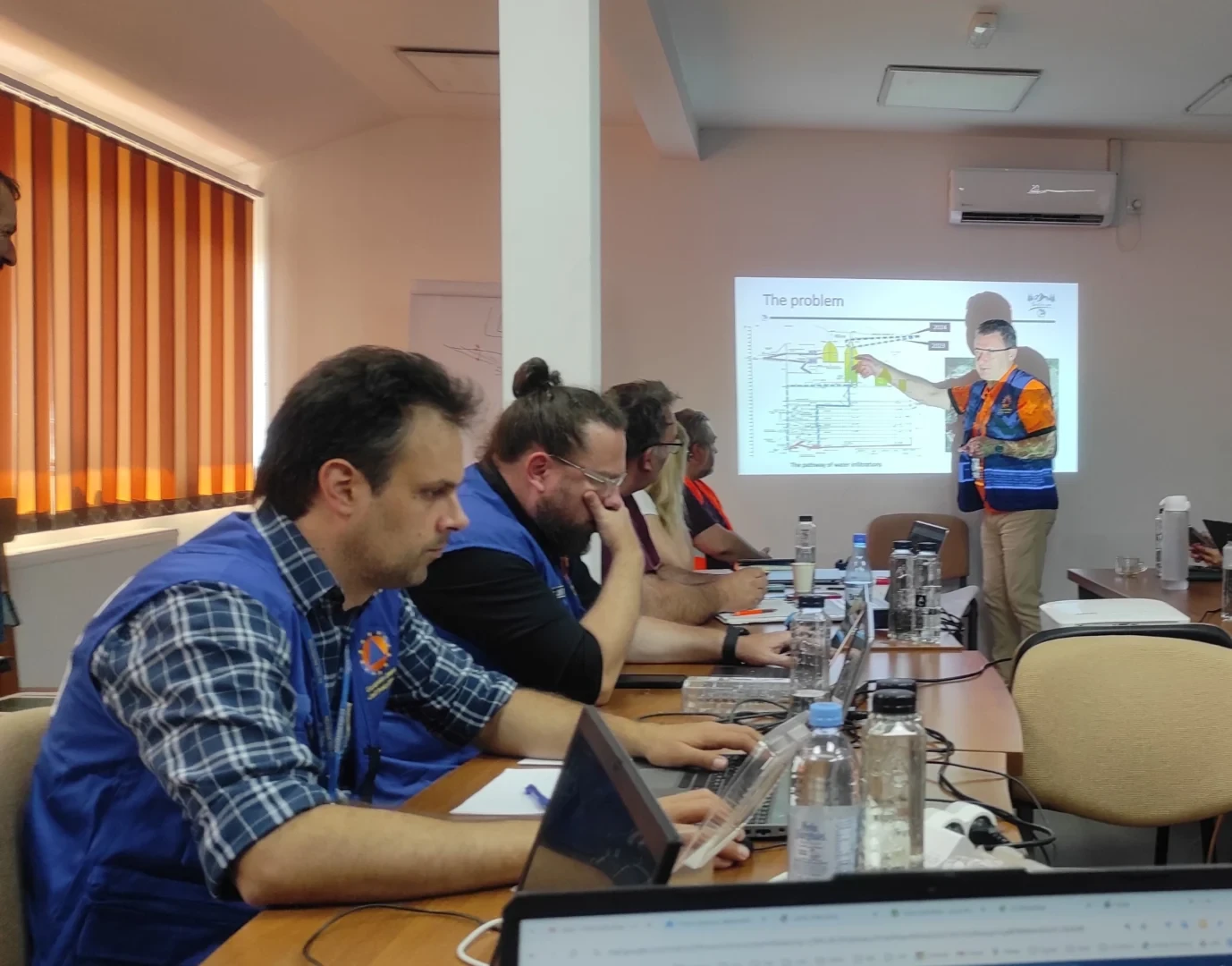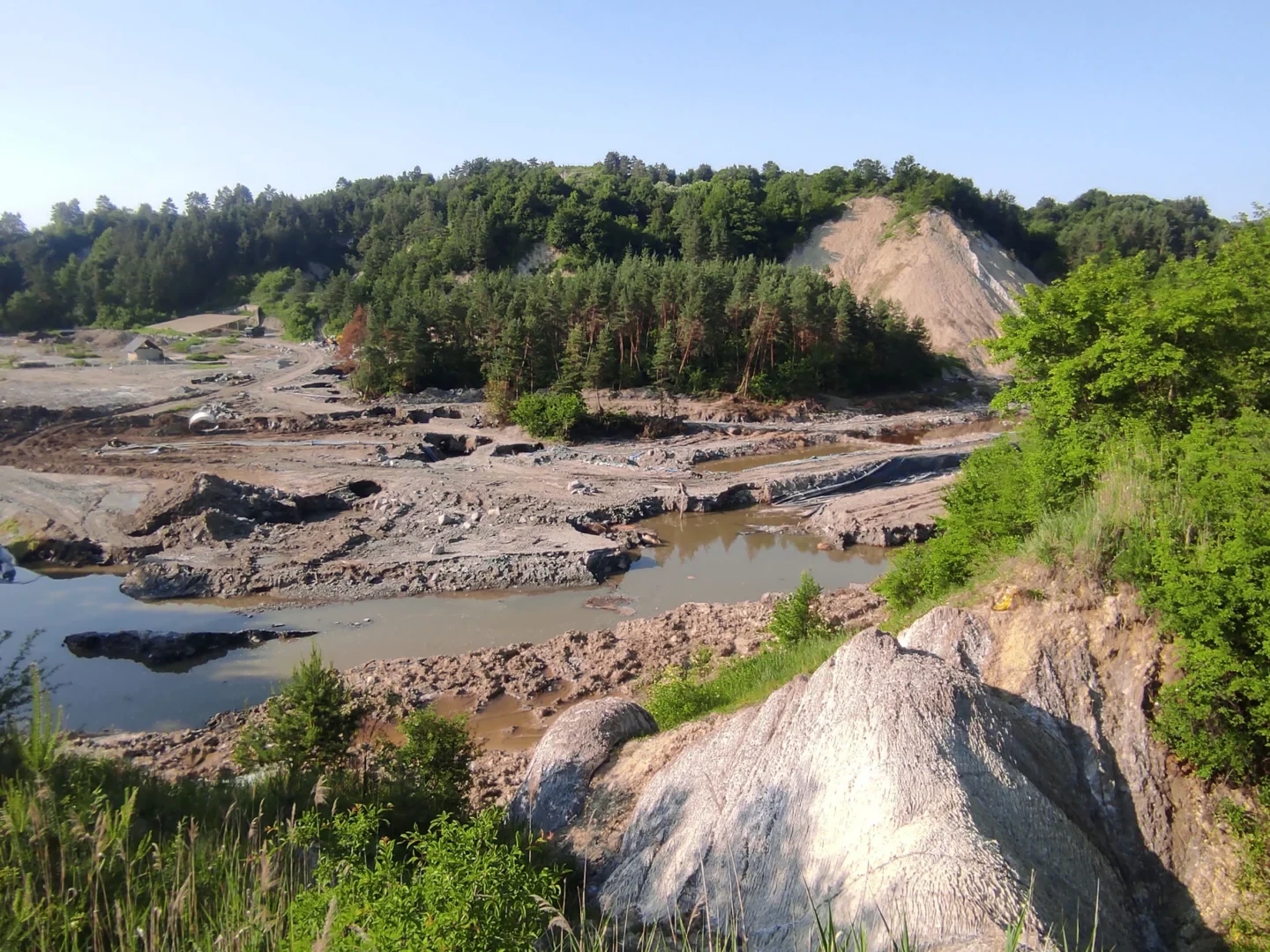According to international literature, no flooded mine has ever been saved from collapse. A global team of experts, including lecturers from the Faculty of Earth and Environmental Sciences and Engineering at the University of Miskolc, is attempting to prove the opposite by assessing the effects of the natural disaster that struck the salt mine in Parajd.
We spoke with Dr. Balázs Kovács, head of the Department of Engineering Geology and Civil Engineering, about the proposals compiled from expert analyses based on fieldwork, and about plans to ensure the safety of the population and, in the long term, even save the salt mine.
At the end of May, a hundred times the usual amount of water poured down the Korond stream above the salt mine in Parajd. The flood broke through both the natural and artificial stream beds created during flood protection measures, and the water flooded the mine through several sinkholes. On June 2, Romania requested expert assistance from member states under the European Union Civil Protection Mechanism. You were selected to join German, Dutch, and Spanish engineers on a mission organized by the European Union Emergency Response Coordination Center. What was your task?
The Romanian side requested expert assistance in assessing the damage and finding solutions to remedy the disaster situation in relation to mining, underground waters, rock mechanics problems, and environmental damage control. Together with Dr. Márton Tóth, who works at the University’s Institute of Water and Environmental Management, we joined an international mission consisting of Dr. Attila Joó, associate professor at BMGE, László Kovács, managing director of Kőmérő Kft., two German engineers, one Dutch engineer, and one Spanish engineer.
Due to the nature of our mission, the main questions we were asked on site were what posed the greatest threat to the population and, in connection with this, how the stability of the mine cavities could be maintained. While searching for solutions, the question arose as to how to prevent freshwater infiltration from further weakening the mine and how to prevent salt water from escaping from the flooded mine.
Have you encountered a similar situation before?
The literature contains numerous cases from Romania, Ukraine, Poland, and the United States where water flooded salt mines that were either in operation or had already been abandoned. I participated in the investigation of a flooded salt mine in Ukraine, but every case is different. What they all have in common, however, is that in the long term, collapses occurred at each site, often with catastrophic consequences. To our knowledge, no flooded mine has ever been saved. Today, however, we have advanced tools at our disposal which, combined with some of the favorable characteristics of the Parajd mine, offer hope for saving the mine.

What is the biggest problem when a salt mine is flooded?
Rock salt is characterized by its high solubility. When large amounts of fresh water suddenly flood a salt mine, a very intense dissolution of salt from the walls begins. This effect was reinforced in Parajd by the destructive impact of the powerful flood. However, the dissolution of the walls may have been reduced by the salt stored in the mine cavities, but not yet transported out, which was more easily soluble than the compact material of the mine walls. According to concentration measurements, a salt-saturated equilibrium state was reached relatively quickly, at which point the further dissolving effect of the liquid ceased.
What is the significance of this?
The experience of water ingress in the Parajd mine in previous years also confirms that, due to low porosity, water can only dissolve the salt wall to a limited extent, to a maximum thickness of a few tens of centimeters, until the salt reaches saturation. In terms of the stability of the mine, a completely new situation has arisen, as the tunnels are now estimated to be filled with 4-7 million cubic meters of concentrated water containing 330 grams of salt per liter. This in itself has prevented the mine cavities from collapsing, because the concentrated salt solution acts a bit like an extra-dense liquid that retains its shape and fills the space – in this case, supporting the mine walls. In certain areas, the mine is now more stable than it was before.
However, near-surface cavities are already experiencing collapses. What is causing this?
Mining areas flooded with fresh water collapse when either the sidewalls can no longer withstand the load upon them, or when the mine chambers’ ceilings cave in due to the ever-widening spans created by dissolution. Experience so far shows that such collapses have always occurred gradually, both in the past and during the current disaster, and this is likely to remain the case in the future. However, if the inflow of fresh water into the Parajd mine cannot be stopped, salt dissolution—especially in near-surface zones that are already in a critical mechanical state—will continue, making smaller or larger collapses probable.

Can we prepare for this process, or is there a way to establish and maintain a stable state?
The salt-mine disasters described in the literature took place decades ago, when neither adequate financial resources nor the necessary technical prerequisites were available to prevent collapses. At Parajd, the situation is entirely different today. We can work to save the mine using 21st-century technology, and we have numerous options to control the processes. A modern movement and environmental monitoring network has already been installed in the region, providing up-to-date information on conditions, detecting surface and subsurface changes, and forecasting any shifts in the salt rock. This system will also prove useful later if phased dewatering of the mine workings is undertaken. With close monitoring of these processes, there is a real chance that the Parajd mine can be saved—becoming a functioning salt mine for the first time in history.
What is required to make this a reality?
First, the current equilibrium inside the mine must be preserved. In the short term, the volume of water entering the mine needs to be reduced. In the long term, the most reliable solution would be to divert the stream’s course around the salt diapir, which would completely prevent further water inrushes. Looking ahead, constructing a safe, artificial channel through the Sószoros gorge could even preserve the region’s natural atmosphere and beauty.
Do they consider it possible to fully restore the Parajd salt mine to its former condition within any timeframe?
Complete restoration is unlikely. If no further disaster occurs, it may be possible to lower the water level in the mine chambers to some extent, enabling tourism and mining activities in the galleries that were used for these purposes before.
In our view, this could only happen once the stream has been regulated and its course relocated—thereby preventing the mine workings from flooding again and ensuring safe discharge of floodwaters. In principle, it cannot be ruled out that the entire mine might be drained, but it’s not necessarily a problem if it isn’t fully dewatered, since the lower level of the Turda salt mine also features a visitor-accessible mine lake as a tourist attraction.
Understandably, there is economic and local pressure to start dewatering as soon as possible and to finish quickly, but doing so now could endanger the mine’s continued existence. Moreover, the saturated brine that would be extracted must be disposed of or desalinated safely and in an environmentally friendly way—a very costly process. Numerous machines and pieces of equipment remain in the mine cavities, which could impact water quality; therefore, this aspect will also need to be assessed in the future.

You mentioned that the mine’s stability is partly due to the concentrated brine. In its current state, can this liquid—so harmful to the natural environment — be retained inside the mine?
Nature solved this problem very well. The Parajd salt body, covering nearly one and a half square kilometers and extending two kilometers deep, has survived over millions of years because it’s enveloped by a thick, water-tight clay layer that prevented the once-precipitated salt from re-dissolving. Smaller leaks have caused surface dissolutions even on hundred-thousand-year timescales—forming salt caves and sometimes human-accessible passages, as here — but most of the salt remained intact. Today, this natural barrier still blocks water exchange between the salt dome and its surroundings, preventing concentrated brine from escaping.
The cyanide pollution of the Tisza coming from Transylvania was an example of how vulnerable the Carpathian Basin’s water system is, of which Hungary’s territory is also part. Could a similar danger exist in the case of Parajd?
It’s known from press reports that the salt dissolved and suddenly released from the mine caverns caused severe damage to the ecosystems of the Korond and Little Küküllő streams, with after-effects even reaching Hungary. In my opinion, if we succeed in reducing and maintaining at a low level the amount of saline water escaping from the mine and the salt dome area, a stably sustainable system will develop, so that, beyond continuous monitoring, no further measures currently appear necessary.